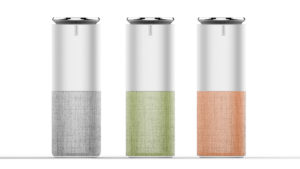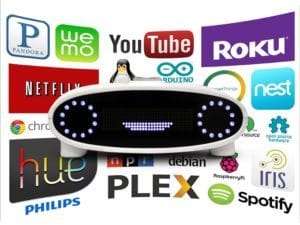The Amazon Echo has steadily grown in popularity since its release, with more homes opting to add the device as the centerpiece of their smart home technology.
While the Amazon Echo is a great piece of technology to have in a home, there are also plenty of Amazon echo alternatives that should be explored before making a decision.
1) Cubic
 While the device has not been released yet, the Cubic is sure to be a strong contender against the Echo. Pre-release reviews have generally been positive, and the company behind the Cubic has demonstrated some of the functionalities that accompany the device – all of which prove to be pretty impressive.
While the device has not been released yet, the Cubic is sure to be a strong contender against the Echo. Pre-release reviews have generally been positive, and the company behind the Cubic has demonstrated some of the functionalities that accompany the device – all of which prove to be pretty impressive.
The device is able to take on a myriad of tasks, from ordering food to looking up television schedules while also being able to control smarthome devices. The accompanying mobile app assists in giving owners directions, controlling home devices and even doling out parking reminders. The Cubic definitely has versatile capabilities, and is sure to be a hit when it is released.
2) Ivee
Another device that is yet to hit the market in this space is Ivee. Built for compatibility, the Ivee is able to support a multitude of smart home systems wirelessly, making it one of a kind. The device is able to support systems such as Nest, Logitech, Hue and a whole host of other systems.
Ivee operates as a wireless Bluetooth speaker as well, which makes streaming music extremely easy. Whether you choose to stream music through an app, or with its built in Spotify capabilities, Ivee as able to handle it.
The device also has voice command functionality, with a 15 foot “hearing radius” for calling out to the device. Or if you are farther away, you can use the companion smartphone app for commands. It is also comparatively smaller than other devices in this space, coming in at about 5″ tall – making it perfect for smaller homes and apartments.
 The newest company to join the fray, Lenovo very recently debuted its new smart home product, the Smart Assistant. Available for purchase in May 2017, Lenovo currently plans to only release the product in China and North America initially.
The newest company to join the fray, Lenovo very recently debuted its new smart home product, the Smart Assistant. Available for purchase in May 2017, Lenovo currently plans to only release the product in China and North America initially.
Built in collaboration with Amazon, it responds to voice commands and functions range from reading out news reports to streaming music, and everything in between.The device also allows users to link and command other smart home products.
In conjunction with Amazon’s Alexa Voice Services technology, the device has intelligent voice control to other internet-connected products that have a microphone and speaker. Lenovo boasts that its key differentiator is the superior quality of their speakers in comparison to the Amazon Echo.
4) Mycroft
 An open source Amazon Echo alternative, Mycroft is ready to enter the market and take on heavyweight softwares such as Apple Siri, Amazon Echo and Microsoft Cortana.
An open source Amazon Echo alternative, Mycroft is ready to enter the market and take on heavyweight softwares such as Apple Siri, Amazon Echo and Microsoft Cortana.
Utilizing a variety of different open source hardware and software components for its platform, Mycroft is definitely a unique addition to the smart home technology scene. The device is powered by a Raspberry Pi 2, and its features make it powerful enough for Mycroft to operate.
The software is powered by Snappy, a minimalist Linux OS created by the makers of Ubuntu. Once Mycroft is connected to the home wifi, it can talk to a multitude of different platforms. These include Nest, Belkin WeMo, Philips Hue and Samsung SmartThings.
The device is also capable of running popular apps with minimal fuss. These include Netflix, Spotify, Youtube and Pandora. It also has speakers integrated, which means it is fully capable of playing your favorite playlists.
5) Athom Homey
 The Athom Homey is also a activated controller for smart homes. A surprisingly open platform, it the device is able to communicate via Wi-Fi, Bluetooth, infrared and many other methods.
The Athom Homey is also a activated controller for smart homes. A surprisingly open platform, it the device is able to communicate via Wi-Fi, Bluetooth, infrared and many other methods.
The device is outfitted with approximately seven different wireless radios. This functionality allows the device to connect and sync with almost any other smarthome device present. It contains natural language processing support, which means that Homey is able to carry out any tasks it is asked to do so, even when speaking normally, something critical for any Amazon Echo alternative hoping to gain an edge. The device is also capable of being tapped into remotely, and allows for smartphone connectivity via an app to access any devices connected to the Homey.